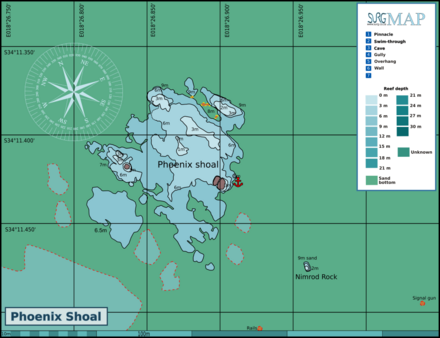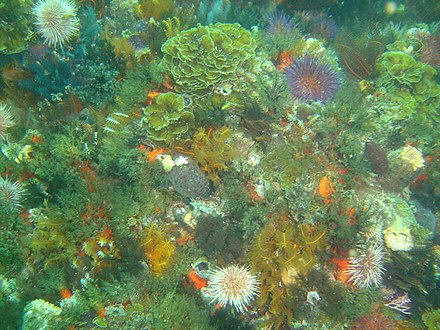Diving the Cape Peninsula and False Bay/Phoenix Shoal
Diving the Cape Peninsula and False Bay/Phoenix Shoal
The dive site Phoenix shoal is an inshore rocky reef and historical wreck in the Seaforth area on the False Bay coast of the Cape Peninsula, near Cape Town in the Western Cape province of South Africa.
Understand

 See also: Diving the Cape Peninsula and False Bay#Understand
See also: Diving the Cape Peninsula and False Bay#Understand
Position
- Phoenix Shoal 📍: S34°11.388' E018°26.898' Wreckage is 80 m due 001°T (025°magnetic) from the rock that covers. About 440 m offshore at Phoenix shoal, to the east of the Simon’s Town harbour, towards Noah’s Ark rock.
This site is in a Marine Protected Area (2004). A permit is required. The site is entirely inside the Boulders Restricted Zone.
Name
The Phoenix was a British ship of 500 tons, built in 1810. It was wrecked a little to seaward of Phoenix Shoal in Simon's Bay on 19 July 1829 while on a voyage from Ceylon with passengers and a cargo of sundries, part of which was saved. No lives were lost. She was armed with two cast iron cannon. Some of the iron ballast can be seen on the reef, while her stem lies buried in sand.
Depth
Maximum depth is about 10 m. Parts of the shoal reach the surface, and there is an extensive area of shoal shallower than 6 m.
Visibility
Visibility is not generally very good, though it may be better than the more exposed areas of the bay when the wind is southerly or south easterly. On the other hand, if the water is reasonably flat, the visibility is not usually very bad, and this is a site which may be diveable when others are too murky.
Topography
Scattered low to medium profile reef on flat sand bottom. Whale vertebra and rib or jawbone on sand. Encrusted iron wreckage on sand at S34°11.388', E018°26.898'. Buried but with a bit showing above the sand. Probably structure of the Phoenix. The wreckage mostly lies in a gap between two shallower sections of reef at the north eastern side of Phoenix shoal, as shown on the map.
Geology: Late Pre-Cambrian granite of the Peninsula pluton and fine quartz sand.
Conditions
This is a shallow dive, in an area well protected from south west swell, but quite exposed to the north-westerly wind, which may raise a bit of a chop and make it difficult to find the wreck, though unlikely to cause much surge. The north-wester can cause a current that sets east in this area. The site is also exposed to south easterly winds and chop.
The site is usually at it's best in winter, but there are also occasional opportunities during other times of the year.
Facilities
Parking is adequate and tarred (since the aerial photo). The parking area is used by tour buses, use the smaller marked bays. There are three major parking areas close to the beach, with paved pathways to the beach and easy shore access to the water. There is a restaurant and public toilets near the eastern parking area.
Get in
See also: Diving the Cape Peninsula and False Bay#Boat dives
Usually a shore dive, but also sometimes accessed by boat from Miller's Point slipway or Simon's Town jetty.
Turn off the main road into Martello road at the IMT sign at the end of the long brick wall enclosing the navy dockyard. Pass the sportsground and park behind the IMT building. Access to the beach is through the gate to the beach to the right of the IMT main gates, over the dunes to the beach. The water is shallow to the left near the building and there is some dense kelp around the boulders.
There is also parking and beach access down Seaforth road, a little further southeast. The parking is paved to the east and gravel to the west, and between these parking areas there is a public toilet. Between the paved parking and the sea there is a restaurant.
The site is about 5.2 km from Miller's Point slipway, and about 2.2 km from Simon's Town jetty, which is at the bottom of Wharf street.
See
Marine life


Features
Wreckage of a wooden ship of historical interest.
Photography
This is not a site with much to photograph, and macro equipment is most likely to produce worthwhile results. Occasionally in good visibility it may be possible to get good results with a wide angle lens and natural light.
Routes
Swim straight out to the wreck on the surface, Dive and explore the wreckage, then swim back to shore on compass bearing 255° magnetic.
Stay safe
See also: Diving the Cape Peninsula and False Bay#Stay safe
Hazards
No site specific hazards known.
Skills
No special skills required.
Equipment
See also: Diving the Cape Peninsula and False Bay#Equipment
No special equipment required, A compass is useful for navigating back under water at the end of the dive.
Nearby
Back to the Alphabetical list of sites, or list of dive sites in the Seaforth to Froggy Pond area
Other regional dive sites: